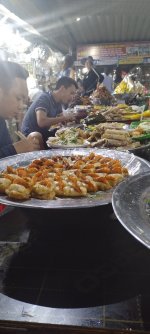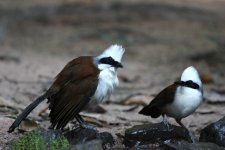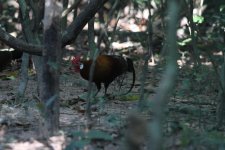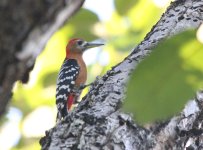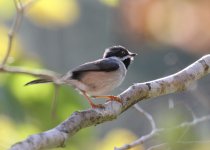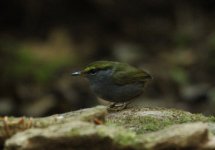ovenbird43
Well-known member

I've just returned from a month-long, solo trip covering most of Cambodia, southern Vietnam, and central Laos. I used professional guides with drivers for all of Cambodia and most of southern Vietnam, though I birded Cat Tien National Park on my own, and I did Laos independently. Though independent birding is always my preference when feasible, most of the top birding sites in Cambodia are owned by local communities, so entry would be difficult to arrange without the help of a guide; for Vietnam, my choice to use guides was a combination of access to birding hides and other local knowledge, as well as arranging transport to areas that would otherwise be difficult to reach on my own. In Laos, it was extremely easy to rent a car and to find information about my primary target there (Bare-faced Bulbul) online.
My overall itinerary was as follows:
Nov 29: Depart from Gulfport, Mississippi. Stopovers in Atlanta and Paris before arriving in Ho Chi Minh City the morning of Dec 1. Domestic flight to Da Nang, transfer to Hoi An Love.Ly Hostel.
Dec 2-3: General sightseeing around Hoi An with some casual birding. Original plans for snorkeling and scuba dashed because it turns out this is the wet season here (unlike the other regions visited on this trip), so dive shops were closed and my snorkeling trip was canceled due to poor visibility
Dec 4-5: Birding Bach Ma National Park with Mr. Phuong from Ecoguidevietnam (Bach Ma Birding Tour -). Flight Da Nang to Siem Reap, Cambodia, evening of Dec 5.
Dec 6-12: birding Cambodia with Mr. Cham of Cambodia Bird Guide Association (Best Birding and Nature Tours from Siem Reap). Sites included Prek Toal Waterbird Sanctuary, Phnom Kron wetlands, Changkron Roy community forest, Bengal Florican reserve, Tmatboey, and Kratie, with a stop en route to Phnom Penh for Cambodian Tailorbird. Pm flight back to HCMC on Dec 12.
Dec 13-18: birding with Mr. Quyen of Vietnam Birding Tours (Vietnam Birding) around Di Linh and Da Lat for highland and endemic species. Dec 18 afternoon drop-off at Cat Tien National Park
Dec 19-21: solo birding around Cat Tien. Dec 21 transfer to HCMC for flight to Vientiane, Laos.
Dec 22-26: travel via rental car to Ban Nahim and birding that area for Bare-faced Bulbul and Sooty Babbler. Dec 26 flight back to HCMC
Dec 27: Flight home, with a 22-hour layover in Paris allowing for some sleep and birding before arriving back home late on Dec 28
Trip Preparation
I applied for eVisas to all three countries online roughly ten days before departure and found the process easy for all of them. I booked most non-tour accommodation prior to my trip using booking.com, or Agoda.com in the case of the Forest Floor Lodge inside Cat Tien National Park. I booked internal flights prior to departure, using Vietjet for HCMC to Da Nang, Cambodia Angkor Air for Da Nang to Siem Reap and Phnom Pehn to HCMH, and Lao Airlines roundtrip HCMC to Vientiane. All flights were smooth and hassle-free. Heck, so were all my international flights! Other than immigration lines at HCMC that just seemed to get longer every time I entered or exited the country.
I obtained local currencies in each country using ATMs, which always had an English language option. The US Dollar is accepted in populated areas of Cambodia, though they can be finicky about the quality of the bills, and ATMs often only dispensed dollars in $100 denominations. I used Cambodian Riels for most expenses except for paying my tour balance and guide tip. A note about the Lao Kip: don't leave Laos with too much unspent or unexchanged cash, I couldn't find anywhere in HCMC (whether in the airport or in the city center) that would take them for exchange. Perhaps it would be different if your next destination were in Thailand or northern Vietnam. Fortunately what I had left only amounted to about $20.
For both study and travel, I used the Lynx and BirdLife International Birds of Vietnam and Birds of Cambodia field guides. I also downloaded the southeast Asia pack for Merlin, which I frequently consulted while in the field (for viewing species profiles - using Merlin to try to identify songs and calls in Asia is a waste of time). When birding Laos, I found that having Birds of Vietnam and the Merlin pack were sufficient for my needs (especially since by then I was familiar with the common and widespread species).
Details to follow!
My overall itinerary was as follows:
Nov 29: Depart from Gulfport, Mississippi. Stopovers in Atlanta and Paris before arriving in Ho Chi Minh City the morning of Dec 1. Domestic flight to Da Nang, transfer to Hoi An Love.Ly Hostel.
Dec 2-3: General sightseeing around Hoi An with some casual birding. Original plans for snorkeling and scuba dashed because it turns out this is the wet season here (unlike the other regions visited on this trip), so dive shops were closed and my snorkeling trip was canceled due to poor visibility
Dec 4-5: Birding Bach Ma National Park with Mr. Phuong from Ecoguidevietnam (Bach Ma Birding Tour -). Flight Da Nang to Siem Reap, Cambodia, evening of Dec 5.
Dec 6-12: birding Cambodia with Mr. Cham of Cambodia Bird Guide Association (Best Birding and Nature Tours from Siem Reap). Sites included Prek Toal Waterbird Sanctuary, Phnom Kron wetlands, Changkron Roy community forest, Bengal Florican reserve, Tmatboey, and Kratie, with a stop en route to Phnom Penh for Cambodian Tailorbird. Pm flight back to HCMC on Dec 12.
Dec 13-18: birding with Mr. Quyen of Vietnam Birding Tours (Vietnam Birding) around Di Linh and Da Lat for highland and endemic species. Dec 18 afternoon drop-off at Cat Tien National Park
Dec 19-21: solo birding around Cat Tien. Dec 21 transfer to HCMC for flight to Vientiane, Laos.
Dec 22-26: travel via rental car to Ban Nahim and birding that area for Bare-faced Bulbul and Sooty Babbler. Dec 26 flight back to HCMC
Dec 27: Flight home, with a 22-hour layover in Paris allowing for some sleep and birding before arriving back home late on Dec 28
Trip Preparation
I applied for eVisas to all three countries online roughly ten days before departure and found the process easy for all of them. I booked most non-tour accommodation prior to my trip using booking.com, or Agoda.com in the case of the Forest Floor Lodge inside Cat Tien National Park. I booked internal flights prior to departure, using Vietjet for HCMC to Da Nang, Cambodia Angkor Air for Da Nang to Siem Reap and Phnom Pehn to HCMH, and Lao Airlines roundtrip HCMC to Vientiane. All flights were smooth and hassle-free. Heck, so were all my international flights! Other than immigration lines at HCMC that just seemed to get longer every time I entered or exited the country.
I obtained local currencies in each country using ATMs, which always had an English language option. The US Dollar is accepted in populated areas of Cambodia, though they can be finicky about the quality of the bills, and ATMs often only dispensed dollars in $100 denominations. I used Cambodian Riels for most expenses except for paying my tour balance and guide tip. A note about the Lao Kip: don't leave Laos with too much unspent or unexchanged cash, I couldn't find anywhere in HCMC (whether in the airport or in the city center) that would take them for exchange. Perhaps it would be different if your next destination were in Thailand or northern Vietnam. Fortunately what I had left only amounted to about $20.
For both study and travel, I used the Lynx and BirdLife International Birds of Vietnam and Birds of Cambodia field guides. I also downloaded the southeast Asia pack for Merlin, which I frequently consulted while in the field (for viewing species profiles - using Merlin to try to identify songs and calls in Asia is a waste of time). When birding Laos, I found that having Birds of Vietnam and the Merlin pack were sufficient for my needs (especially since by then I was familiar with the common and widespread species).
Details to follow!










